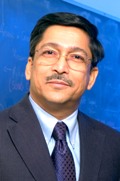The 77th Joseph Henry Lecture
Arsenic in Ground Water
Aquatic Chemistry and Mitigation through a Sustainable Filtration Technology
Abul Hussam
Associate Professor
Department of Chemistry and Biochemistry
George Mason University
Sponsored by Larry Millstein and Robin Taylor
About the Lecture
The presence of toxic levels of arsenic in groundwater of Bangladesh and in many parts of the world is now known to cause serious health problems including cancer. Arsenic is primarily present as inorganic forms, where arsenite is the most toxic species. This talk will cover the aquatic chemistry of these species and the phenomena of natural attenuation of arsenic species in groundwater with experimental data and chemical equilibria. Finally, the chemistry of a simple and extremely efficient method for the filtration of arsenic species from groundwater will be discussed. The method uses a composite iron matrix as the arsenic scavenger material. This presentation will cover the present crisis of potable water in Bangladesh and its possible solution through the development of a sustainable filtration technology called SONO filter.
About the Speaker

ABUL HUSSAM is an Associate Professor in the department of chemistry and biochemistry at George Mason University, Fairfax, Va. He received the Grainger Challenge Gold Award of $1 million for his SONO filter, a household water treatment system. His invention is already in use today, preventing serious health problems in Bangladesh. In 2007, he was named as one of the “Heroes of the Environment” by Time. He was born in Kushtia, Bangladesh. He graduated in Chemistry (B.S. Honors and M.S.) from the University of Dhaka and earned his Ph.D. in Analytical Chemistry from the University of Pittsburgh in Pennsylvania. He has published and presented more than 90 scientific papers in international journals, proceedings, and books. In collaboration with others, Abul Hussam has established an environmental research laboratory in Kushtia and is actively engaged in educating the public on the nature of present and future environmental crises.